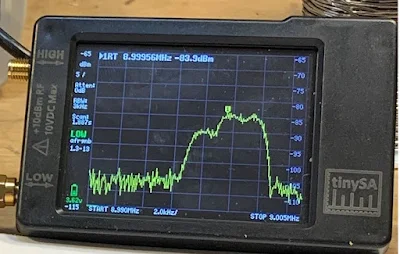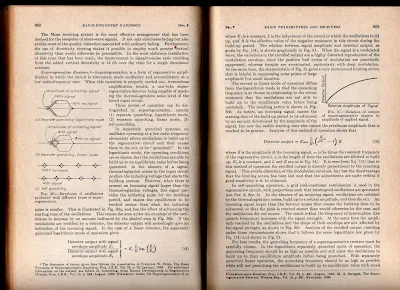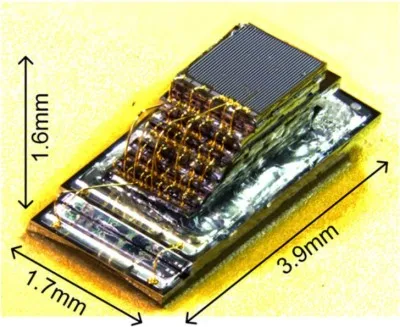Serving the worldwide community of radio-electronic homebrewers. Providing blog support to the SolderSmoke podcast: http://soldersmoke.com
Podcasting since 2005! Listen to Latest SolderSmoke
Monday, November 8, 2021
Save $2970! Build this $30 DIY Microphone!
Sunday, November 7, 2021
JPL, Mars Helicopter, Cube Sats, Ham Radio and more: N5BF talks to Eric Guth 4Z1UG
Here is Eric's page on this interview, with useful show notes:
https://www.qsotoday.com/podcasts/n5bf
I like to listen to Eric's shows on YouTube -- here is the YouTube recording of the N5BF interview:
https://www.youtube.com/watch?v=Fbr4jE11vfg
Here is N5BF's ham radio web site:
http://cbduncan.duncanheights.com/HamRadio/HamRadio.html
Here is the club page of the San Bernardino Microwave Society:
http://www.ham-radio.com/sbms/
Thanks to Eric and Courtney!
Saturday, November 6, 2021
M0NTV's "Crystal Filters for the Fearful" (video)
Friday, November 5, 2021
The Importance of Keeping the Noise FLAT
Wednesday, November 3, 2021
Tuesday, November 2, 2021
Farhan's Amazing Knack Story: From a Boyhood SW Receiver to the Design of the sBITX SDR
-- Farhan talks about his practice of taking the pictures of new rigs with the new rig sitting atop the book that was most important in its design and construction. FB.
-- I was really blown away by Farhan's presentation of how the uBITX advertisement was inspired by and in many ways based on the Heathkit ad for an HW-101. Amazing.
-- I learned a lot from Farhan's discussion of SDR theory. I pledge to spend more time with this. I really like Farhan's hybrid HDR/SDR approach.
-- But I have a question: Farhan seems to say that we'd need a big expensive GOOGL computer to do the direct sampling HF SDR. But doesn't the little RTL-SDR do just that? Without a GOOGL?
-- Great to see Wes's AFTIA being used in the sBITX.
-- Really cool that Farhan has his mind on VHF transverters when designing the sBITX. I liked use of the TCXO module to free up one of the Si5351 clock outputs. FB. And great to include an idea from Hans in this rig.
Thanks very much to Farhan (who stayed up until 3 am to do this!) and to the RSGB for hosting.
Sunday, October 31, 2021
Buy a Real Sputnik Satellite! Let's Put Sputnik Back in Orbit!
Here's the description:
---------------
Laboratory Test Model of "Sputnik 1 EMC/EMI", 1957
1:1 scale test model of the satellite "Sputnik-1", serial no. "0K6-1/004/1957", with built-in transmitter (including modern 12-volt power supply), polished stainless-steel sphere, consisting of two threaded hemispheres of approx. 23 in. diameter with two pairs of antennae of 95 in. and 105 in. at an angle of 35 degrees to the axis, on stand with O-ring, stand approx. 59 in. high, stand and model together approx. 79 in. high, accompanied by a Tesla Maj 620A radio receiver, manufactured in Prague c. 1956, restored working condition, including replacement of the silver-zinc battery with a modern alternative and a new metal casing for the electronic transmitter. Note: Built at the Experimental Design Bureau-1 (OK?-1/OKB-1) factory, also known as S.P. Korolev Rocket and Space Corporation Energia, Koroljow, Soviet Union, in 1957, shortly before the launch of Sputnik-1. - An impressive artefact from the dawn of the space age, of which few models are known. - Provenance: From the collection of Dr. Frank Malina, USA/CSSR.
Start Price: EUR 85.000
Here's my suggestion: Musk or Bezos or Branson should buy this thing, fix it up a bit, and put it back in orbit. So we can listen to it again. I know a version of this was done back in 1997. But I think we should do it again, this time with the actual test model.
Here are the earlier SolderSmoke blog posts about Sputnik and Sputnik-related projects:
https://soldersmoke.blogspot.com/search?q=Sputnik
Steve Silverman sent the auction posting to me. Thanks Steve.
It just so happens that earlier in the week I was out at the Air and Space Museum facility near Dulles Airport, where I saw this flight backup of the Vanguard satellite:
Saturday, October 30, 2021
Using Noise to Sweep a Filter with the TinySA
Wednesday, October 27, 2021
Why Does Solder Smoke Always Go Right Into Your Face? Now We Know
How to Listen with your TinySA
Tuesday, October 26, 2021
SETI, Proxima Centauri, The Parkes Dish, and Intermodulation Distortion?
A cosmically interesting troubleshoot. But I'm not sure about their explanation. Why would the intermod disappear when they moved the Parkes Radio Telescope off of Proxima Centauri?
Monday, October 25, 2021
Putting a Ceramic Filter in the "Mate for the Mighty Midget" Receiver
Sunday, October 24, 2021
WA9WFA's Mate for the Mighty Midget 1966 QST Receiver

Friday, October 22, 2021
Tribal Knowledge: Pete N6QW on "How to Make Things Work"
Check out Pete's great advice here:
Wednesday, October 20, 2021
Super-Regeneration is Super-Strange
Tuesday, October 19, 2021
Homebrew Tiny Space Telescopes from the Netherlands
Monday, October 18, 2021
No Longer On the "Shame Shelf" -- Pete Fixes His KWM-1
Sunday, October 17, 2021
2 Meter Homebrew: The Fredbox (Video)
Wednesday, October 13, 2021
SolderSmoke Podcast #233: PIMP, Boatanchors, Novices, MMM, Heathkits, DC Receivers, Mailbag
SolderSmoke Podcast #233 is available.
http://soldersmoke.com/soldersmoke233.mp3
Travelogue: Cape Cod. SST. Marconi Site.
The WFSRA: The World Friendship Society of Radio Amateurs.
Pete's Bench:
The Pimp.
The NCX rig.
The Collins.
The many DC receivers built worldwide.
The parts shortages are real! Several key radios on hold. Si5351 sub.
Talk to G-QRP convention
Bill's Bench:
FT-8. Not for me. I tried it.
Novice Station Rebuild.
Globe V-10 VFO Deluxe.
Selenium rectifier removal CONTROVERSY?
Not crazy about my Novice station. Not crazy about CW.
Mate for the Mighty Midget. Again.
Mike W6MAB -- Detector problems LTSPICE Check
One more mod for MMM RX. Ceramic filter at 455.
Dropped screw inside tubular cap on Millen 61455 transformer.
Talk to the Vienna Wireless Society
Thinking of a Moxon or a Hex beam.
BOOK REVIEW Chuck Penson WA7ZZE New Heathkit Book. http://wa7zze.com
Mailbag
-- New SPRAT is out! Hooray!
-- Todd K7TFC sent me copy of Shopcraft as Soulcraft. FB.
-- Dean KK4DAS building an EI9GQ 16 W amp. FB.
-- Jack NG2E Getting close on Pete's DC receiver.
-- JF1OZL's website is BACK!
-- Tony K3DY sent link to cool books.
-- Sheldon VK2XZS thinking of building a phasing receiver.
-- Peter VK2EMU has joined the WFSRA. FB!
-- Ned KH7JJ from Honolulu spotted the Sideband Myth in the AWA video.
-- Chris M0LGX looking at the ET-2, asks about the variometer.
-- Pete Eaton Nov 64 anti HB rant in november 1964 QST. Wow.
-- Josh Lambert Hurley spreading FMLA stickers in the UK. FB
-- Stephen VE6STA getting ready to melt solder.
-- Got a great picture of Rogier PA1ZZ back on Bonaire.
-- Farhan reading the manual of Hans's new digital rig.
-- Paul G0OER wonders if FMLA getting ready to move on 5 meters.
Saturday, October 9, 2021
Recent Homebrew Projects from Jan PA3GSV (of "Mate for the Mighty Midget" Fame)
Recent talk of the Mate for the Mighty Midget receiver and Pete's PIMP SSB transmitter brought me back in contact with the work of Jan, PA3GSV. I took a look at his QRZ.com page and found that he has some projects that rival even his seemingly unbeatable MMM RX project.
Check it out for some real homebrew eye candy:
Friday, October 8, 2021
Bill's 52 year-old Apollo 11 Time Capsule -- What Should I Do?
Thursday, October 7, 2021
Another M^3: The Michigan Micro Mote
Move over Michigan Mighty Mite and Mate for the Mighty Midget. There's a new M^3 in town. And it is SMALL.
Hack-A-Day had an article on this today, and while it seems only tenuously connected to ham radio, I found it intriguing.
Tuesday, October 5, 2021
Dean KK4DAS Builds an EI9GQ 16 Watt RF Amplifier (and Noodles in the Process)
Monday, October 4, 2021
Scott WA9WFA's Mate for the Mighty Midget Receiver is WORKING! (Video)
Saturday, October 2, 2021
Selenium RECTIFIED
Selenium rectifiers. The name kind of sounds like Dilithium crystals, possibly related to flux capacitors.
Anyway, there were two of them in the Globe Electronics V-10 VFO Deluxe that I recently bought. Obviously they had to go, so I took them out yesterday, replacing them with a 1N5408 silicon rectifier.
The new diode had a significantly lower voltage drop than the selenium rectifiers -- this pushed the output voltage from the power supply up to around 200V. It is supposed to be around 185 V. So I put a 470 ohm, 5 watt resistor (found in the junkbox) in series. This brought the output voltage to 167 V. Close enough. VFO seems to be working fine.
I'm glad I did the extraction before these aging components released their nasty toxic smoke.
W3HWJ has a good article on replacing these nasty old parts, with some interesting info on their history: http://www.w3hwj.com/index_files/RBSelenium2.pdf
Backgound on the element Selenium: https://en.wikipedia.org/wiki/Selenium
Friday, October 1, 2021
Chuck Penson's Amazing New Book about Heathkit Amateur Products
Wednesday, September 29, 2021
N2CQR (WN2QHL) Novice Station Re-Created
Tuesday, September 28, 2021
The World Friendship Society of Radio Amateurs
Rod's son David Newkirk is radio wizard himself and has produced many great articles for QST and other publications. His dad is a Silent Key and David has taken his call.
This morning I was looking at an article on David's web site in which he looks at some of his dad's old QSL cards. Most of the affiliations on the cards (ARRL etc.) are easily recognizable, but there was one that was unclear: WFSRA.
David figured out what it was:
--------------------------------------
A W9BRD Affiliation Mystery Solved
My father's pre-World-War-Two QSL cards include the usual list of affiliations: ORS (Official Relay Station), RCC (Rag Chewer's Club), WAC (Worked All Continents), A-1 Op (A-1 Operator's Club). One affiliation, WFSRA, remained mysterious. A clue in the correspondence column in March 1938 QST pointed me to an "I. A. R. U. News" item on page 74 of July 1935 QST, and I had my answer:
W.F.S.R.A.:
The World Friendship Society of Radio Amateurs has requested publication of the following pledge, which is the sole obligation for membership in the Society:
"I hereby promise that I will, to the best of my ability, make such use of my amateur radio station as will be conducive to international friendships; that I will never voluntarily permit by station to be used as the tool of selfish nationalistic interests; and that I will do what I can, as a radio amateur and as an individual, to promote world peace and understanding. (To be followed by the signature, address and station call.)"
Membership in the Society is open to all amateurs in all countries. All that is necessary to become a member is to copy and sign the pledge, and send it to the secretary, Duane Magill, W9DQD, 730 N. 6th St, Grand Junction, Colorado, U.S.A. Copies are preferably to be made in English or French, but may be made in the language of the member."
-----------------------------------
The WFSRA was apparently one of the many, many peace organizations that were born in the interwar period in response to the carnage of WWI. In addition to the QST correspondence mentioned by David, Google shows WFSRA in many articles in UK ham and SWL publications, and there is one mention of it in the May 1954 edition of Boy's Life magazine.
Much as the CBLA seems to have been presaged by the FMLA, the IBEW seems to have much in common with the WFSRA.
Monday, September 27, 2021
Lighthouse Larry's GE Sideband Handbook
Saturday, September 25, 2021
VE7SL's Beautiful Single Tube Transmitter and Single Tube Regen Receiver
RECEIVER: https://qsl.net/ve7sl/neophyte.html
TRANSMITTER: https://qsl.net/ve7sl/neotx.html?fbclid=IwAR3cM6tSRjyTsNouHWVz_buuzz4C9O-IwQbdZM5dekkle69ZW7-JBQcHTVI
Three cheers for Steve VE7SL! I've been linking to his blog for several years, but somehow I missed this magnificent red rig.
Steve's online notebook: https://www.qsl.net/ve7sl/
Steve's blog: http://ve7sl.blogspot.com/
Friday, September 24, 2021
Video: N2CQR Talks About Homebrew SSB with The Vienna Wireless Society's Makers Group
Thursday, September 23, 2021
Great News for Homebrewers: JF1OZL's Amazing Web Site is Back!
https://www.qrp-ja.net/jf1ozl/index.html
There is a LOT of tribal knowledge and lot of great ideas on his site. Kazuhiro-san has apparently quit wireless, but is climbing mountains near his home. We hope is doing well and that he will someday return to radio (perhaps for the peak of cycle 25).
We last posted about him back in 2011. In the comments to that post you can see the sad news about the demise of his web site (which is now back on the web):
http://soldersmoke.blogspot.com/2011/12/homebrew-hero-kazuhiro-sunamura-jf1ozl.html
JF1OZL's bio:
My name is Kazuhiro Sunamura. I am a 50 year old mechanical engineer, born in 1956. I am not an engineer in electronics. I have been interested in electricity and radio from the age of ten. For the last ten years, I have been active on my ham radio station JF10ZL. I have also written articles about my some of my radio projects in Japanese for the Japanese CQ Magazine. Now I have decided to get onto the internet and will take the opportunity of showing you my equipment and ideas. Please have a look at my schematics. I will be very happy if this material helps you with your own radio projects. I am a member of the J.A.R.L. affiliated Tsuchiura Club, the local ham club in my home town.




































